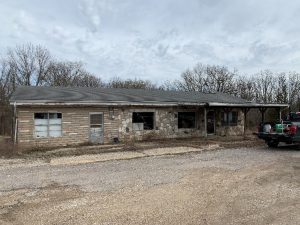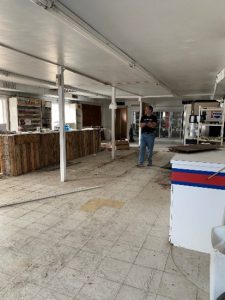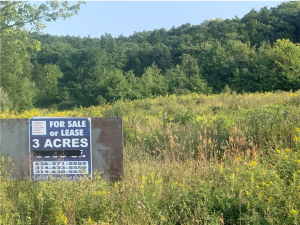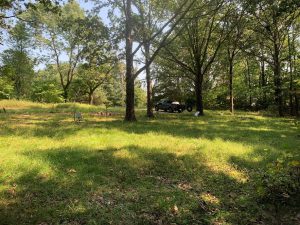Part 5 – A Place for My Honey House
By: James Masucci
Have you ever juggled? You can’t just focus on one ball; you must keep an eye on the whole bunch of them. Seems like you can never spend enough time on one because the next one is always falling. Well, this seems to be my experience with putting up my honey house. I thought I’d share these experiences so you can learn from them. I am NOT saying that I know what I’m doing or going about this the right way. But, perhaps by sharing my experience and thought processes, you can have an idea of what to expect and figure out a better way.
It all starts with a location. A suitable site, however, is dependent on how I am going to use the facility. How big MAY I grow and what MAY I use this for? “May” is critical here. I don’t want to make a huge investment on something I will outgrow in five years. Then again, I don’t want to build something I will never come close to occupying. Things to think about: How much equipment do you plan on storing? Will there be any fleet vehicles to store? Will this need to be an inspected facility? Will you be moving things by hand, pallet jack, or forklift? Will you have a full extraction line?
Many of these questions relate to how big of a building you need. However, the site is just as important. If you are large enough, you will be getting freight shipments. Will there be room for delivery trucks? If there are fleet vehicles, are they stored in a building or will you fence in the property? Will the garage and storage sheds be part of, or separate from, the honey house? Answers to these questions tell you whether you need one acre or five acres.
For me, I want a single building that will serve as a garage, a honey house, and storage facility. The garage will be a walled off section for my bee truck. I will have a second room for a kitchen/bottling facility that will pass inspection (though I am not big enough for that, yet). It will have a bathroom/shower/laundry room to help me pass inspections as well as eliminate my wife handling bee garments in our personal laundry. Lastly, it will have plenty of space for extracting and storage. I want to park my truck indoors because it will be unattended for long periods of time. I need enough space for delivery trucks and random equipment. I don’t plan on having bees on this property, because I don’t want a feeding frenzy when I’m bringing in honey supers, but I still don’t want to be right next to neighbors. I know from experience that bees and neighbors don’t always mix. So, I went looking for a couple of rural acres, keeping in mind that I need water, sewer/septic, and electricity. Living in the suburbs of St. Louis, land is not cheap. The farther away I go, the cheaper the land gets, but the farther I need to travel to my “base camp” every day. My strategy was to be within 15 minutes of one of my yards. Then, once I have my “base camp” established, I can expand around it so that eventually, it is in the middle of all my bees rather than the outskirts.

First look; an old gas station. Close, but not right. Floor space is not an open design, no place for deliveries (including supers) and the floor was not very solid.
 The first place I looked at was an old gas station (from the ‘50s) that had the gas tanks removed and had been on the market for five to 10 years (see picture). It had water, sewer, and electricity. It also had an old cold room which I could use to store boxes (prevent wax moths). However, it was not built on a slab which would prevent me from ever using a forklift. There was no place to park my truck and no delivery access (garage door) on the building. John Miller told me, “think Walmart, open building, one floor, easy access to everything”. It could work but wasn’t right for me. Besides, it was 25 minutes beyond my farthest yard and not in a great area.
The first place I looked at was an old gas station (from the ‘50s) that had the gas tanks removed and had been on the market for five to 10 years (see picture). It had water, sewer, and electricity. It also had an old cold room which I could use to store boxes (prevent wax moths). However, it was not built on a slab which would prevent me from ever using a forklift. There was no place to park my truck and no delivery access (garage door) on the building. John Miller told me, “think Walmart, open building, one floor, easy access to everything”. It could work but wasn’t right for me. Besides, it was 25 minutes beyond my farthest yard and not in a great area.

Not a bad property. Relatively flat and only 5 minutes from my closest bee yard. I would need to bring in electric, dig a well, and put in a septic system. But $120,000? No way
The second spot I looked at was seven acres smack in the middle of all my yards. Perfect location, until I went to see it. $80,000 for a steep hillside that didn’t have a single place for me to build. No water, no sewer, no electricity, no deal. The third location I found while driving around. “3 acres for sale” in a perfect location. I stopped on the road and called the realtor. “…you mean the commercial property on the outage road? That’s $3 a square foot”. “What?” I said, “you want $120,000 an acre?”. His reply….”you are obviously new to looking at commercial property”. Oh yes I was. At this point, the gas station was looking better. I had a couple more of those conversations which helped me narrow down where I needed to look, the type of land I was looking for (agricultural) and what I should expect to pay. And the search continued.

This is it! The top is relatively flat. Ten minutes from my closest bee yard. Sewer, water, and electric on the property and a good location for someone to build a nice home when we are finished with it. AND, it comes with a tire swing.
One Thursday night, we had some friends over for dinner and, as usual, they asked “how are the bees?” After hearing about our land search, one of our friends told me how he constantly searches the MLS listings because he is looking for a place in the general area I’m looking and offered to pass along anything that he finds. That Sunday morning, I found an e-mail from him in my inbox. A two-acre plot that used to have a trailer on it (so it was relatively flat), that had water, sewer, and electricity on site. Water, sewer, and electricity alone are worth a lot of money. I had to visit a beeyard out there, so I stopped by….10 minutes from the yard. I immediately envisioned where I would put the building. Plenty of space for the building and for delivery trucks. I called my wife as I as going to my next yard and we agreed to see it when I got back home. As we drove into the yard around noon, we met the owners. Had a great conversation. My wife liked it. By five o’clock, the property was ours with the contingency that the county would allow for the building that I wanted to put up. They did. It’s ours.
What gave us the confidence in this property to buy it the same day we saw it (besides that there were two other offers that day…)? First was location. The property is five minutes from a town that is on the edge of the urban sprawl that’s happening in our area. When I retire from beekeeping in 10-15 years, we think we will more than get our money back for the property. Second is location (location, location, location, right). The property is 10 minutes from the out-yard closest to my house and 15 minutes from the next one in line. Fairly convenient from my beeyards even though it is 30 minutes from my house. Third is location. It’s in a great area to expand my yards into. It will be an excellent centralized location for my bee operation. Fourth, it had all the utilities that I will need. Sewer, water, and electricity are on site. I just need to tap in. Fifth, it has sufficient space and a couple great building sites (more on that in my next article) for the building I want to put up and any extra storage that I may need in the future. Sixth, the county that it is in is Ag friendly and business friendly making code compliance relatively easy and the building department very helpful. Seventh is neighbors, or lack thereof. To the South of the building site, I own 100 feet of lawn and 200 feet of woods. Beyond my woods are more woods, then pastureland. To the west is a two acre empty plot of woods and next to that is a non-retail business. To the north is a house at least 100 yards away with a tree line in between. To the east is the only real neighbor and between the building site and them is a thick tree line.
So now I have my land. The next step is the preparation for putting up the building. Determining size, developing a floor plan , getting appropriate permits, and finding people to do the work that I don’t how to do. But that’s for the next article.
Click here to go directly to Part 4 – A Shout Out to My Friends
Click here to go directly to Part 6 – Getting Ready to Build






